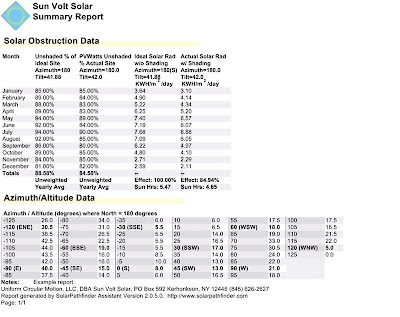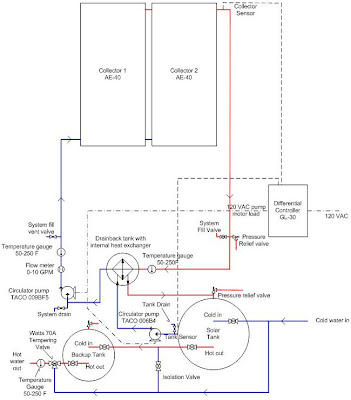Evaluating a Domestic Solar Hot Water System
Top 5 things to evaluate when choosing a Domestic Solar Hot Water system (SDHW)
With the price of energy skyrocketing, many people are looking into ways to reduce their energy use and thus expenses. Solar systems, particularly SDHW systems are an excellent way to do just that. SDHW systems are often less expensive than their cousins, photovoltaic systems, and generate more energy per square foot of roof space. SDHW systems work well in any climate in the US. Department of Energy
Like any renewable energy resource, there are a few considerations:
1. Solar resource. In order for a homeowner to get their money’s worth, a good southern exposure that is un-shaded between the hours of 9am to 3pm every day of the year is required. Some defused sunlight, such as through a deciduous tree without leaves, is tolerable but it will cut down on the amount of energy received. These difficulties can often be overcome by installing slightly larger solar collectors. A complete solar analysis with a solar pathfinder is the best way to determine how well a solar system will work in any given location. 2. Hot water usage. This is the basis for a SDHW system’s size. The more people or potential people living in a household, the more hot water is used. The general rule of thumb is 20 gallons each for the first two people per day, then 15 gallons each per day for every additional person. Thus a typical family of four would use 70 gallons of hot water per day.
2. Hot water usage. This is the basis for a SDHW system’s size. The more people or potential people living in a household, the more hot water is used. The general rule of thumb is 20 gallons each for the first two people per day, then 15 gallons each per day for every additional person. Thus a typical family of four would use 70 gallons of hot water per day.
3. Aesthetics. Some people do not like the look of a solar collector. They are basically an aluminum frame with a glass cover. If the front of a house faces south, they will need to be installed on the front of the house. Often times, a SDHW will work better if the panels are tilted at greater than the roof pitch. If that is not what you want, then you may need to reconsider whether solar power is for you.
4. Cost effective design. This is where a good solar installer will make all the difference between a system that pays for it self quickly, and one that doesn’t pay for itself at all. A good design takes into consideration the roof area needed, any decrease in system performance due to orientation (away from true south), specific usage criteria (more or less use at certain times), and backup water heating. Using inexpensive components may seem like a good way to save money, but in the long run, it will cost you. Each installation is slightly different from the last and often there are special design criteria that need to be met.

5. Installation. Several things need to be addressed; will the collectors fit on the roof, is the roof strong enough to support the additional weight of the collectors, wind loading, viability of the roofing material under the collectors, pipe runs, grounding and balance of system components. All of these items are critical to a good solar installation.
Solar systems require more thought and planning than conventional energy systems, however, they can be an excellent investment for a homeowner interested in saving money long term. They also have added benefits of reducing pollution and increasing energy independence.
—-
This article was written by guest blogger Paul Thurst. Paul writes an excellent blog about home improvement and fixing up his home in the Eastern Catskill Mountains of NY called Homeowner’s Blog. Paul has recently designed and installed a domestic solar hot water system for his home and started his own solar business. I think you’ll find his blog very informative and worth visiting on a regular basis. I want to thank Paul for taking time out of his busy schedule to write this post and share it with my readers.













Such an interesting idea! If my home didn’t face south I would seriously consider it.
Good stuff. Some thermal makes a lot of sense. Check out a short description of a video project we’re starting on. Of interest here because the concept trial piece is about solar hot water. See http://greenhomesamerica.wordpress.com/2009/06/03/solar-hot-water-video/
Thanks,
Mike